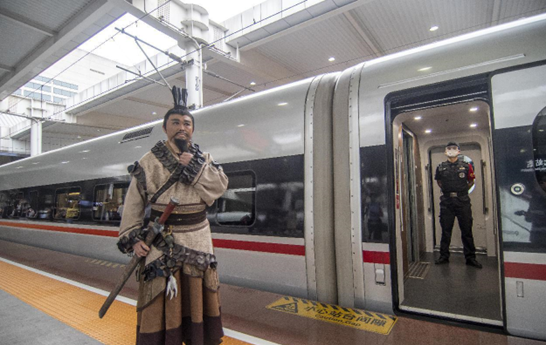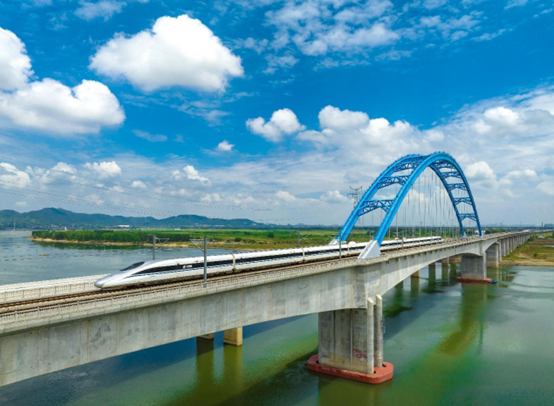By Wang Binlai, Wang Xinyue, People’s Daily
Earlier this month, the Zhengzhou-Chongqing High-speed Railway started full operation as a new section linking Hubei’s Xiangyang and Chongqing’s Wanzhou was put into use.
The railway shortened the trip from Beijing to southwest China’s Chongqing municipality to 6 hours and 46 minutes, and that from Zhengzhou, central China’s Henan province to Chongqing to 4 hours and 23 minutes, bringing closer the city cluster in central China and the Chengdu-Chongqing economic circle.
The Zhengzhou-Chongqing High-speed Railway crosses a region with the world’s most complicated geographical conditions. 98 percent of the overall mileage consists of bridges and tunnels. With complex and variable landscapes, geologic hazards always take place in the region. In addition, the high requirement on environmental protection during the construction also made the project extremely challenging.

For instance, the Xiaosanxia tunnel along the Chongqing section of the railway is the longest single-hole double-track railway tunnel with a designed speed of 350km per hour in Asia. It has the highest level of risk as a railway tunnel in China.
There are 152 outfalls of crack water, interstitial water, and underground rivers, as well as 30 karst caves in the tunnel. The maximum daily water inflow in the tunnel could hit 168,000 cubic meters, which is equivalent to the water storage in over 60 standard swimming pools.
To steer clear of all potential risks, the project team set up multiple professional work groups and adopted a series of technical solutions such as geological radar, horizontal percussion drilling for advanced geological prediction, and geological surveying during the construction. The total mileage in the plans prepared by the project team added up to more than 8,000 kilometers.
The Zhengzhou-Chongqing High-speed Railway was built according to stringent environmental protection standards. There is no bridge pier built in the water in protection zones for water resources that the railway crosses, and the railway adopted single-hole double-track tunnels to reduce excavations. Besides, the railway has chosen gabions over concrete structure, built bionic ecological water systems and restored original wetlands. During the construction, the project team tried its best to fit the railway into the surrounding natural landscape and to minimize the project’s environmental impact.

The operation of the high-speed railway will significantly enhance the flow of passengers, logistics, information, and capital.
“Now we finally enjoy the convenience of direct trains,” said Gao Jianxin, business manager of Lucky Huaguang Graphics Co., Ltd., a company based in Henan province. According to him, he and his colleagues had to make detours via Xi’an in northwest China’s Shaanxi province to go to southwestern provinces such as Yunnan and Guizhou.
The southwestern region is an important market of the company, and the newly-opened high-speed railway will largely reduce the travel time for the company’s employees, Gao said. “The business team of our company is currently working to expand our sales. We must grasp the opportunity brought by the high-speed railway,” he told People's Daily.
Before the Zhengzhou-Chongqing High-speed Railway was put into operation, some high-quality projects of high-end equipment manufacturing and modern services had already been started along the route.
In Yunyang, Chongqing municipality, Sichuan-based Sino-Agricultural Modern Investment Co., Ltd. has invested 1.5 billion yuan ($224.3 million) to build an intelligent cold-chain logistics center. In Wanzhou, Chongqing, more than 20 key projects have commenced, including a cable project for high-end new energy equipment.

“The opening of the Zhengzhou-Chongqing High-speed Railway will do us a great favor in the industrial relocation from central and eastern China to the Chengdu-Chongqing region,” said Wang Haiyun, an official with the economy and information technology committee of Wanzhou. The new technologies and products from enterprises in central and eastern China are expected to accelerate local industrial restructuring and upgrading, he added.
The Zhengzhou-Chongqing High-speed Railway is also bringing the natural scenery, resources and culture along the route closer to the market.
In the past, tourists usually went to the attractions in the Three Gorges, the three adjacent gorges along the middle reaches of the Yangtze River by ship. Today, they can go faster thanks to the newly-opened high-speed railway.
“Tourists were always on ships when they visited the Three Gorges, so they barely made any consumption,” said Li Xuefeng, head of a tourism company, adding that the company will work to attract tourists to stay overnight given the Zhengzhou-Chongqing High-speed Railway.
According to him, a series of leisure and tourism projects have been built in Wushan county, which sits at the western entrance to the Wu Gorge in the Three Gorges region. Thirty-nine hotels and 685 agritainment facilities were built or renovated, he introduced.


